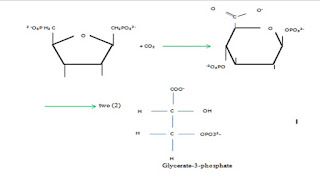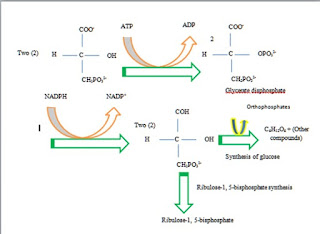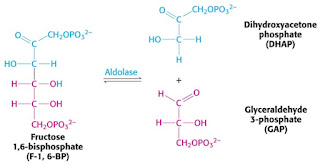Biochemical process of light independent stage of photosynthesis
In this stage carbon (IV) dioxide from atmosphere is
captured and modified by addition of hydrogen to form carbohydrates and other
organic compounds (amino acids and lipids). Carbon (IV) dioxide combines with
ribulose-1, 5-bisphosphate to form unstable six carbons sugar which eventually
breaks down to two (2) molecules of glycerate-3-phospahte, check it here;
Two molecules of glycerate-3-phospate are
phosphorylated by ATP to form two (2) molecules of glycerate disphosphate, NADPH
catalyzes them, reducing them to two molecules glyceraladehyde-3-phospate. One
molecule of glyceraldehyde-3-phosphate is quickly converted to glucose, amino
acids, lipids and other carbohydrates while the other molecule is utilized in
the synthesis of ribulose-1,5-bisphospahte. This process is as follow;
In this process, first stable molecule is glycerate-3-phosphate. Energy carriers
(ATP and NADPH) are used to reduce glycerate-3-phosphate to form
12 molecules glyceraldehyde 3-phosphate, in which two molecules of 12 molecules are removed from the cycle to form
glucose while the remaining 10 molecules for the formation of
ribulose-1,5-bisphosphate.
Note:
ADP, Pi (orthophosphate, NADP+, RUBP (Ribulose-1, 5-bisphosphate) are recycled
for the next process.
QUESTIONS
(1) In
the process of photosynthesis, how many molecules of glyceraldehyde-3-phosphate are used in the formation of glucose and
ribulose-1, 5-bisphosphate?
(2) State
two (2) and one (1) step(s) in glycolytic pathway and pentose phosphate pathway
respectively which are somewhat related to the process of photosynthesis. Name enzymes
which are involved at those specific steps.
ANSWERS
1. In
question one above, the answers are; two
(2) and ten (10) molecules of
glyceraldehye-3-phosphate are used to form glucose and ribulose-1,
5-bisphosphate respectively. As stated above.
2. In
question two, steps are; step number three
(3) where fructose-1, 6-bisphosphate is converted to Dihydroxyacteone and
glyceraldehyde-3-phosphate. This step is catalyzed by aldolase enzyme. In both process (photosynthesis and glycolytic
pathway) there exists glyceraldehye-3-phosphate and that is what bring the
relationship. This picture below shows how(glycolytic
pathway step three(3) ) occurs;
In step number six of glycolytic
pathway, there is relationship between glycolytic pathway and photosynthesis
process represent by gycerate-3-phosphate
(phosphoglycerate isomer). Where 1, 3-bisphosphate is converted
to 3-phosphateglycerate, a reaction catalyzed by phosphoglycerate kinase. See it in this diagram;
In pentose phosphate pathway, the
relationship is exhibited by ribulose-1, 5-bisphosphate, which is formed from
6-phosphogluconate, a reaction catalyzed by 6-phosphogluconate dehydrogenase. See it here (in step 3 of
Pentose Phosphate Pathway);








Comments
Post a Comment